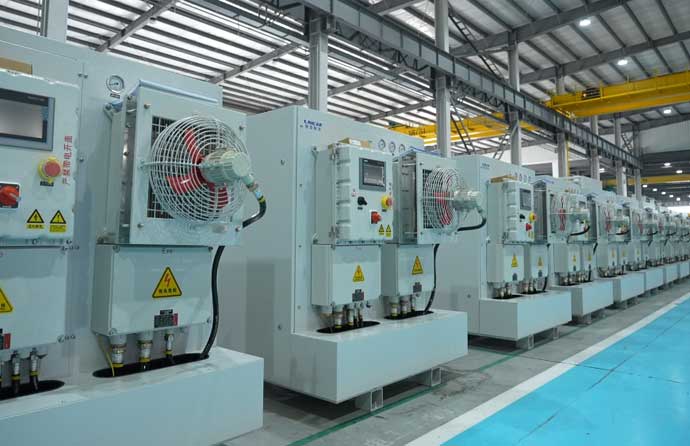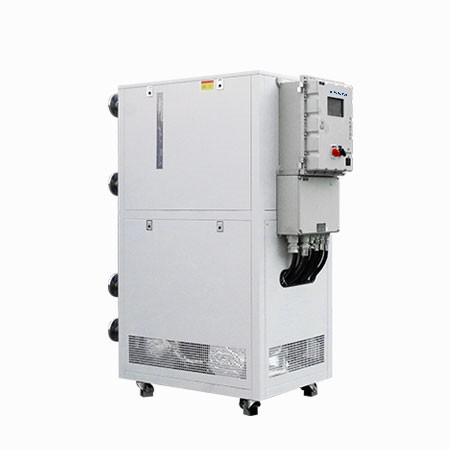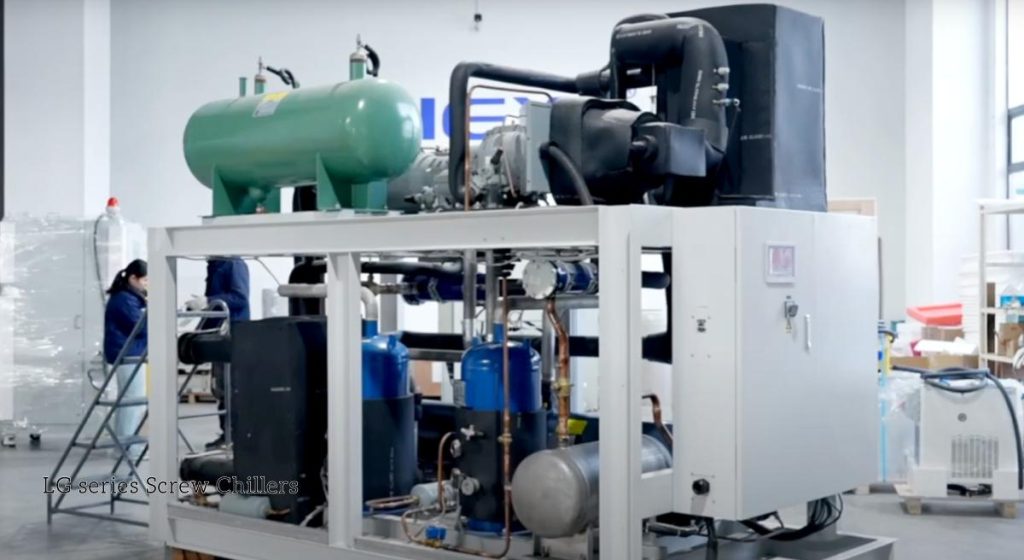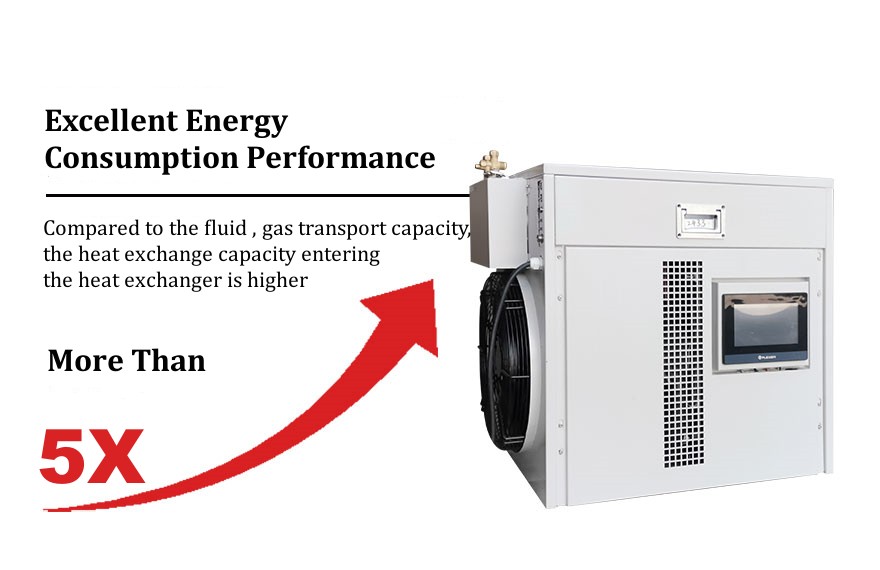Können Kältemittel in Chillern gemischt werden?
Unsere Chiller-Techniker sind dieser Frage unzählige Male begegnet: „Kann ich meinen Chiller einfach mit einem anderen Kältemittel nachfüllen, wenn das ursprüngliche zur Neige geht?“ Wenn Kunden diese Frage stellen, liegt es oft daran, dass Zylinder verwechselt werden, sie Zeit sparen wollen oder das genaue Kältemittel nicht verfügbar ist.
Das Mischen von Kältemitteln in einem Chiller verursacht in der Regel Probleme. Anfangs scheint es manchmal in Ordnung zu sein, aber früher oder später treten abnormale Leistungen oder sogar Ausfälle auf.
Situationen, in denen Kältemittel gemischt werden
Im Einsatz passiert das Mischen von Kältemitteln meist unbeabsichtigt. Vielleicht haben Sie noch eine Flasche von einem anderen Auftrag übrig, oder ein Techniker nimmt an, dass zwei Kältemittel ähnlich genug sind. Manchmal war das ursprüngliche Kältemittel in einem älteren System nicht klar gekennzeichnet. In anderen Fällen wollen Menschen einfach ein paar Euro sparen und denken, ein „ähnliches“ Kältemittel mache keinen Unterschied.
Aber jedes Mal, wenn dieser Abkürzungsweg gewählt wird, wird der Chiller einer Belastung ausgesetzt, für die er nicht ausgelegt ist. Möglicherweise fällt es Ihnen nicht sofort auf, doch die Folgen zeigen sich oft in seltsamen Leistungsproblemen, höheren Energiekosten oder sogar einem beschädigten Kompressor.

Why Can’t Refrigerants Be Mixed in Chillers?
Es gibt einen guten Grund, warum Chiller-Hersteller davor warnen. Ein Chiller ist nicht einfach nur eine Kiste mit Rohren. Jedes Teil – der Kompressor, die Ventile, sogar die Dichtungen – hängt davon ab, dass sich das Kältemittel auf eine bestimmte Weise verhält. Das Mischen von zwei Typen verändert die Chemie des Systems. Und glauben Sie uns, dem Chiller wird das nicht gefallen.
Chemische Verträglichkeit
Kältemittel schweben nicht einfach nur herum, sie vermischen sich mit dem Öl, den Dichtungen und den Gummidichtungen. Wenn Sie verschiedene Typen mischen, kann es zu eingedicktem Öl, Korrosion oder Schlamm im System kommen. Wir haben gesehen, wie Kompressoren zerstört wurden, weil das Öl nach einer Vermischung seine schützenden Eigenschaften verloren hat. Sobald das passiert, verschleißen Metallteile schneller und das System wird zum Wartungsalbtraum.
Leistungsminderung des Kältemittels
Jedes Kältemittel hat exakte Siedepunkte und Kondensationspunkte. Mischt man zwei Typen, verschieben sich diese Punkte. Das Ergebnis? Sobald Kältemittel gemischt werden, kann der Chiller Schwierigkeiten haben, die Temperatur stabil zu halten. Er könnte längere Zyklen fahren oder einfach träge wirken. Anfangs scheint es geringfügig, doch nach einigen Wochen leidet die Effizienz deutlich.
Kompressorstress
Der Kompressor ist der heikelste Teil. Gemischte Kältemittel verändern Drücke und Dampfdichte, wodurch der Kompressor härter arbeiten muss. Lager verschleißen schneller, Vibrationen verschlimmern sich und die Austrittstemperatur steigt stark an. In einigen Fällen führt dies zu einem katastrophalen Kompressorausfall, und der Austausch ist nicht billig.
Garantieverlust
Die meisten Chiller-Garantien geben ausdrücklich an, dass die Verwendung des falschen Kältemittels den Garantieanspruch erlöschen lässt. Wenn Ihr System durch Vermischung beschädigt wird, übernimmt der Hersteller keine Reparaturen. Manche Kunden mussten dies akzeptieren – der Versuch, bei den Kältemittelkosten zu sparen, führte letztlich zu zehnfach höheren Reparaturkosten.
Erhöhter Energieverbrauch
Even if the chiller keeps running after a mix, efficiency drops. The system cycles longer, pumps run harder, and heat transfer isn’t optimal. It’s subtle at first, but over months, energy bills climb. A “cheap fix” for refrigerant now often turns into a long-term cost headache.
Wie kann man das Mischen von Kältemitteln verhindern?
Das Verhindern von Kältemittelmischungen erfordert Disziplin.
Erstens: Beschriften Sie Zylinder immer eindeutig. Führen Sie ein Protokoll über jedes in jedem Chiller verwendete Kältemittel. Wenn Sie eine ältere Einheit ohne Dokumentation übernehmen, lassen Sie das Kältemittel von einem Fachmann analysieren, bevor Sie etwas hinzufügen.
Bei der Umrüstung auf eingestellte oder auslaufende Kältemittel arbeiten Sie mit einem qualifizierten Techniker zusammen. Das bedeutet, das Öl zu wechseln, die Materialverträglichkeit zu prüfen und sicherzustellen, dass die Systemdrücke mit dem neuen Kältemittel übereinstimmen. Abkürzungen an dieser Stelle sind die Hauptursache für unbeabsichtigte Mischungen.
Schließlich: Schulen Sie Ihr Wartungsteam. Ein Techniker, der die Folgen der Kältemittelmischung versteht, ist viel weniger geneigt, Abkürzungen zu nehmen. Es geht darum, das System zu schützen und langfristige Probleme zu reduzieren.
Schlussfolgerung
Wenn Sie nicht sicher sind, welches Kältemittel Ihr Chiller verwendet, oder vermuten, dass es zu einer Vermischung gekommen ist, warten Sie nicht. Lassen Sie eine Kältemittelanalyse durchführen und beheben Sie das Problem, bevor Leistungsprobleme oder Kompressorschäden auftreten.
Die richtige Verwendung des richtigen Kältemittels sorgt dafür, dass der Chiller reibungslos läuft, länger hält und Energie spart. Es mag unbedeutend erscheinen, aber mit der Zeit wirkt es sich erheblich auf Leistung und Energiekosten aus.
Kontaktieren Sie LNEYA für weitere Informationen oder ein Chiller-Angebot.

- Chiller Components and Refrigeration Fundamentals Guides
- Chiller Types and Selection Guides
- How Does a Peltier Cooler Work
- Peltier Chiller vs. Compressor Chiller
- What Is a Peltier Chiller
- OEM vs Aftermarket Chiller Spare Parts
- Chiller Surge
- Chiller Cooling Capacity Units
- Dezember 2025
- November 2025
- Oktober 2025
- September 2025
- August 2025
- Juli 2025
- Juni 2025
- Mai 2025
- März 2025
- Februar 2025
- Januar 2025
- Dezember 2024
- November 2024
- Oktober 2024
- September 2024
- August 2024
- Juli 2024
- Juni 2024
- Mai 2024
- April 2024
- März 2024
- Februar 2024
- September 2023
- Juli 2023
- Juni 2023
- Mai 2023
- Januar 2023
luftgekühlte Kältemaschine Kühler Installation der Kältemaschine Wartung von Kühlanlagen chiller refrigerant Kältemaschinen Kalte Montage Gefrierschrank Kaltwassersatz Kühl-Heizsystem cooling system dynamisches Temperaturkontrollsystem energieeffizienter Chiller explosionsgeschützter Kühler Gefrierschrank Heizungsumwälzpumpe Industriekühler Industriekälteanlagen Industriekühlung industrieller Gefrierschrank Industriekühlschrank Mantelreaktor Laborkühlschrank Niedertemperaturkühler Nachrichten Ölkühler Prozesskühler process cooling Reaktorkühler Reaktorkühlung Reaktorkühlung Heizung Reaktorheizung Kühlung Kältethermostat Schneckenkühler Halbleiter-Kühlgerät Halbleiter-Testkühler sundi tcu Temperaturkontrolle Prüfkammer Thermostat Ultra-Niedertemperatur-Kühler Fahrzeug-Test-Kühler Kaltwassersatz wassergekühlte Kältemaschine
Verwandte Chiller
KONTAKT US
TEL:
EMAIL:
WeChat & WhatsApp:

Wechat QR

Haben Sie eine Frage oder benötigen Sie ein Angebot? Füllen Sie das untenstehende Formular aus, und unser Team wird sich innerhalb von 24 Stunden bei Ihnen melden.
 LNEYA Industriekühler Hersteller Lieferant
LNEYA Industriekühler Hersteller Lieferant



















